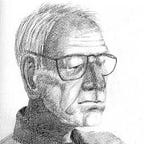Wandering
Preparing for a flight over the North Atlantic — at about a hundred times my walking speed — on another West to East migration from Florida to Bavaria, I thought about Merlin Coverley’s The Art of Wandering: the Writer as Walker. He covered a colorful history over the past few centuries of people and trends in wandering from criminal vagrants jailed for idleness to fanciful flaneurs, who promenaded in the 1840s with tortoises on a leash. Included in this mix were thoughtful wanderers like Rousseau during the Age of Enlightenment, Thoreau a simple-living philosopher, Kerouac of the Beat Generation, naturalist Muir, and many others. One of the most interesting accounts of “wandering” was Albert Speer’s head trips while in Spandau Prison.
Speer was Hitler’s architect and Minister of Armament, sentenced by the Nuremberg Tribunal following WWII to 20 years in prison. He was allowed a brief daily walk in the prison garden. Carefully matching his pace to the garden’s perimeter, he was able to judge his walking speed. With the help of the prison library, he conjured routes around the world. Then he compared daily prison walks, about 7 kilometers per day, to his charted course around the globe. “. . . arrived in Peking, thirteenth year . . . passed Seattle, seventeenth year . . . passed Mexican border nineteenth year.” It was an astounding combination of dedicated physical walks around a small garden perimeter and walking in your head for years on end.
Fortunately for Speer, the Earth is only one third land suitable for walking. The other two thirds are water, and that is where my wandering by sail and sailing in my head come together. By a strange coincidence, most small boat cruising speeds, including the epic voyage of Columbus, take place at speeds of 4–5 nautical miles per hour or roughly in the neighborhood of Speer’s walking pace. Although I am not imprisoned, aging has stopped my sailing adventures that now reside in my head as recollections. Hopefully, I will be able to recall these wanderings for quite some time.
Another thing I share with Speer’s imaginary wandering is the use of maps, or more accurately called charts in sailing vernacular. I imagine Speer’s trekking in his head took place with compass headings and distances covered by his pace. Coverley makes no mention of how wanderers steered their aimless walks or how they knew their position on a map, if they had one.
I feel fortunate to have grown into my sailing hobby in the age of sextant and compass shortly before the age of GPS (Global Positioning System) and chart plotters. Nowadays the noonday sun, moon-rise, and the appearance of selected planets and stars have a special meaning remembered from my sextant sighting recollections just like mountain peaks must have had for John Muir’s compass readings.
After wandering coastal voyages along the East Coast from Maine to the Caribbean, several Atlantic crossings, a circumnavigation of the Scandinavian Peninsula, and a mother-of-all-wanderings, a circumnavigation of the world, I have plenty of voyages in my head probably longer than Speer ever contemplated.
And, whether imprisoned or simply aging, we share this quote:
When one is young, the circle around one’s life is the whole world. In maturity, it becomes your village. In middle age, your house and your garden. And then, when you are old, your bed. Anonymous
